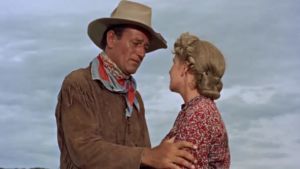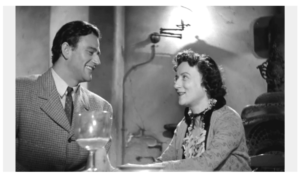
On the cusp of retirement, a Cavalry officer (Wayne) is tasked with evacuating a community of homesteaders before an imminent attack from warring Native American tribes.
The second entry in John Ford’s “Cavalry Trilogy,” She Wore a Yellow Ribbon is most assuredly one of Ford’s finest Westerns. It doesn’t come close to matching the popularity of The Searchers or Stagecoach. However, it’s still a rousing and hard-raising film, bursting with a vibrant Technicolor palette and a booming score accompanying the action.
Hatari!
Sean Mercer (Wayne) is a veteran hunter who makes his living tracking wild animals, capturing them, and selling them to zoos from Africa. So when he agrees to invite a magazine photographer alone on his safari, Mercer is shocked to find the photographer is a woman (Elsa Martinelli), leading to all kinds of comic misadventures.
It’s not often you see Wayne star in a romance film, and even less when you see him star in a romantic comedy. Reuniting with regular collaborator Howard Hawks, Wayne nevertheless has a crowd-pleasing presence at the heart of Hatari!, a role that seems to be almost poking fun at Wayne’s own trademark macho personality.
They Were Expendable
Following the Japanese attack on Pearl Harbor, a squadron of experimental Navy P.T. Boats patrol the Philippines, led by a determined naval commander (Robert Montgomery) and his right-hand man (Wayne).
Montgomery may be the star of this WW2 film, but Wayne still hands in an entertaining turn as Montgomery’s trusty lieutenant. It’s one of John Ford’s most underrated films, characterized by powerful messages about personal sacrifice to achieve victory against overwhelming odds.
Sands of Iwo Jima
![]()
Photo Credit: Republic Pictures
Ahead of the Iwo Jima invasion, the members of an American Marine squad view their sergeant (Wayne) as a cruel, taciturn tyrant who delights in punishing his troops. Upon landing on the Japanese-controlled beaches, though, the soldiers begin to understand the reason for their sergeant’s stringent discipline and bitter attitude.
One of Wayne’s finest dramatic performances, Sands of Iwo Jima illustrated Wayne’s ability to appear as an outwardly menacing, crotchety character who secretly harbors a much softer side he has trouble expressing. Balancing these two perfectly, his performance here feels like an equal mix between his Red River and The Quiet Man characters.
The Long Voyage Home

In the early days of World War 2, the merchant vessel crew do their best to brave against loneliness, drunkenness, boredom, and bitter in-fighting as they cross the Atlantic from the Americas to England.
John Ford’s follow-up to his Oscar-winning 1940 adaption of Steinbeck’s The Grapes of Wrath, The Long Voyage Home benefits from some crisp cinematography and a script from Eugene O’Neill’s celebrated play of the same name. Years before he was typecast as a tough-talking cowboy, Wayne does an impressive turn as a Swedish crewmate longing for home, pouring his woes into hard liquor to escape his homesickness.
How the West Was Won

Photo Credit: Warner Bros. Entertainment Inc.
Spanning numerous decades, How the West Was Won follows several generations of a family settling in the West, facing perilous terrain, hostile Natives, predatory outlaws, and the upheaval of the Civil War.
There’s no questioning How the West Was Won’s scope and ambition, the movie utilizing a massive ensemble cast and sprawling storylines featuring the likes of Henry Fonda, Gregory Peck, Debbie Reynolds, James Stewart, and Eli Wallach, to name just a few stars. Unfortunately, the finished result is a bit overstuffed and overly long. Still, Wayne strolls into the movie for less than five minutes and utterly dominates as Union General William Tecumseh Sherman opposite Harry Morgan’s conflicted Ulysses S. Grant.
3 Godfathers

Photo Credit: Metro-Goldwyn-Mayer
On the run from the law, three cattle rustlers (Wayne, Pedro Armendáriz, and Harry Carey Jr.) adopt a lone newborn they found in the desert, risking their lives and freedom to ensure the baby reaches civilization.
Part comedy, part Western, 3 Godfathers is one of the unsung classics of John Ford and John Wayne’s respective careers. Mixing humor with plenty of heartfelt emotion, it breaks stereotypes regarding traditional cowboy characters, blurring the line between antagonist and protagonist.
Fort Apache

Photo Credit: RKO Radio Pictures
Captain York (Wayne) is a respected Union Cavalry officer who was sent to man the defenses of the isolated outpost known as Fort Apache. There, he clashes with a young, arrogant fellow Civil War veteran (Henry Fonda) who does not understand the local Native American customs.
The first entry in John Ford’s “Cavalry Trilogy,” Fort Apache kicked the trio of films off to a strong start. With its more nuanced and sympathetic portrayal of Native American culture, it’s one of the most forward-thinking films of Wayne’s career — far more so than the problematic portrayals of Indigenous peoples in The Searchers.
Big Jake

Photo Credit: Paramount Pictures
When his grandson is kidnapped and ransomed by a gang of outlaws, a legendary Texan rancher/gunfighter (Wayne) partners with his two estranged sons (Patrick Wayne and Christopher Mitchum) and his Apache best friend (Bruce Cabot) to rescue him.
Arguably the most underrated of Wayne’s many films, Big Jake blends a fairly grittier storyline with first-rate humor, action, music, and performances. In addition, its period setting (the early 1900s) helped the filmmakers utilize historical inventions rarely seen in Westerns at the time. The movie seems like a lighter successor to The Wild Bunch.
The Cowboys

Photo Credit: Warner Bros.
Desperate for help transporting a massive herd of cattle from Montana to South Dakota, a surly rancher (Wayne) reluctantly hires a group of teenage schoolboys to assist him.
Big Jake and The Cowboys have the distinction of being two of Wayne’s most criminally overlooked Westerns. Yet, between the younger cast and a terrifying, expertly-cast Bruce Dern as the wild-eyed antagonist, it’s one of the great movies of Wayne’s later career.
McLintock!

Photo Credit: United Artists
G.W. McLintock (Wayne) is an influential, jovial landowner who uses his friendly attitude to maintain peace and balance in the land between feuding ranchers, power-mad politicians, and the local Comanche tribe.
A rare comedy for the Duke, McLintock! allows Wayne to flex his Shakespearean muscles in this Western take on The Taming of the Shrew. Wayne still relies on the larger-than-life persona he’d spent the previous two decades creating, but it’s always interesting to see him venture more fully into comedic territory.
The Sons of Katie Elder

Photo Credit: Paramount Pictures
Gathering for their mother’s funeral, four estranged brothers (Wayne, Dean Martin, Michael Anderson Jr., and Earl Holliman) put aside their differences to defend their land from a shady businessman (James Gregory).
The Sons of Katie Elder rightfully tends to pale compared to any of the films mentioned above, starring Wayne on this list. When looked at on its own, however, the movie offers an exciting enough premise for a Western, making clever use of Wayne and Martin’s on-screen chemistry and some fantastic performances from character actors like Gregory, George Kennedy, and a young Dennis Hopper.
Hondo

Photo Credit: Warner Bros.
Hondo Lane (Wayne) is a courier and professional scout reluctantly working for the U.S. Army. Stumbling upon a mother (Geraldine Page) and her young son (Lee Aaker) living in Apache-populated territory, Hondo warns the family about an imminent attack from the Natives, ultimately serving as the homesteaders’ protector.
Routinely compared to the Western classic, Shane (both movies being directed by George Stevens), Hondo moves at a much slower pace than the Alan Ladd-led film, utilizing a script that places a heavier emphasis on dialogue, even if it ends with a massive shootout. In his interactions with Page and Aaker’s characters, Wayne demonstrates a more sympathetic side to his usual firebrand characters.
The Horse Soldiers

Photo Credit: Metro-Goldwyn-Mayer Studios Inc.
Deep behind Confederate lines, a Union Cavalry outfit is assigned to destroy a local supply station. Along the way, the unit’s commander (Wayne) repeatedly butts heads with the brigade’s surgeon (William Holden), as well as detaining a Southern belle (Constance Towers) who overheard their assignment.
Officially, The Horse Soldiers isn’t a part of John Ford’s thematically-connected “Cavalry Trilogy.” But when you compare the movie to Ford’s earlier films, it’s nearly as good as any of the director’s three cavalry-centric films, characterized by some memorably great banter between Wayne and Holden’s characters.
El Dorado

Photo Credit: Paramount Pictures
When he learns that his lawman best friend (Robert Mitchum) is under threat from an unscrupulous landowner (Ed Asner) and his hired goons, gunfighter Cole Thornton (Wayne) comes to his friend’s assistance.
Seven years after their momentous collaboration on Rio Bravo, Howard Hawks, and John Wayne reunited for El Dorado, a spiritual remake of their earlier film with an overarchingly similar storyline and characters. Swapping out an alcoholic Dean Martin for an alcoholic Robert Mitchum and a young, perky Ricky Nelson with a young, somber James Caan, the movie is a major drop-off from Rio Bravo — but it’s still far from terrible.
Rio Lobo

Photo Credit: Paramount Pictures
After the Civil War officially draws to a close, a Union officer (Wayne) enlists the help of his former Confederate captors (Jorge Rivero and Christopher Mitchum) in hunting down two Union spies whose betrayal led to the death of his best friend.
The second loose remake of Howard Hawks’ earlier, far better Rio Bravo, Rio Lobo is far and away the weakest of Hawks’ loosely-connected trilogy. Wayne has a notably stronger presence than in the second remake, El Dorado. The movie possesses the darkest tone of the three films. Rio Lobo doesn’t come anywhere close to matching the quality of the original film it’s based upon.

With years of experience in personal finance, Lina is dedicated to providing practical insights and guidance. Her expertise includes budgeting, investing, and next-gen financial strategies.






Leave a Reply